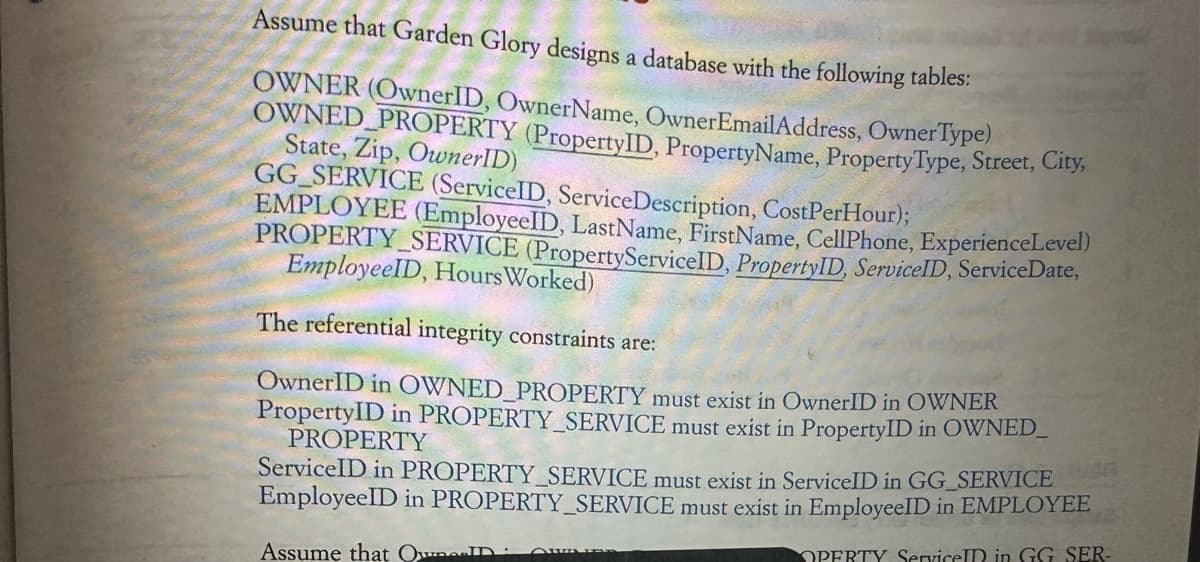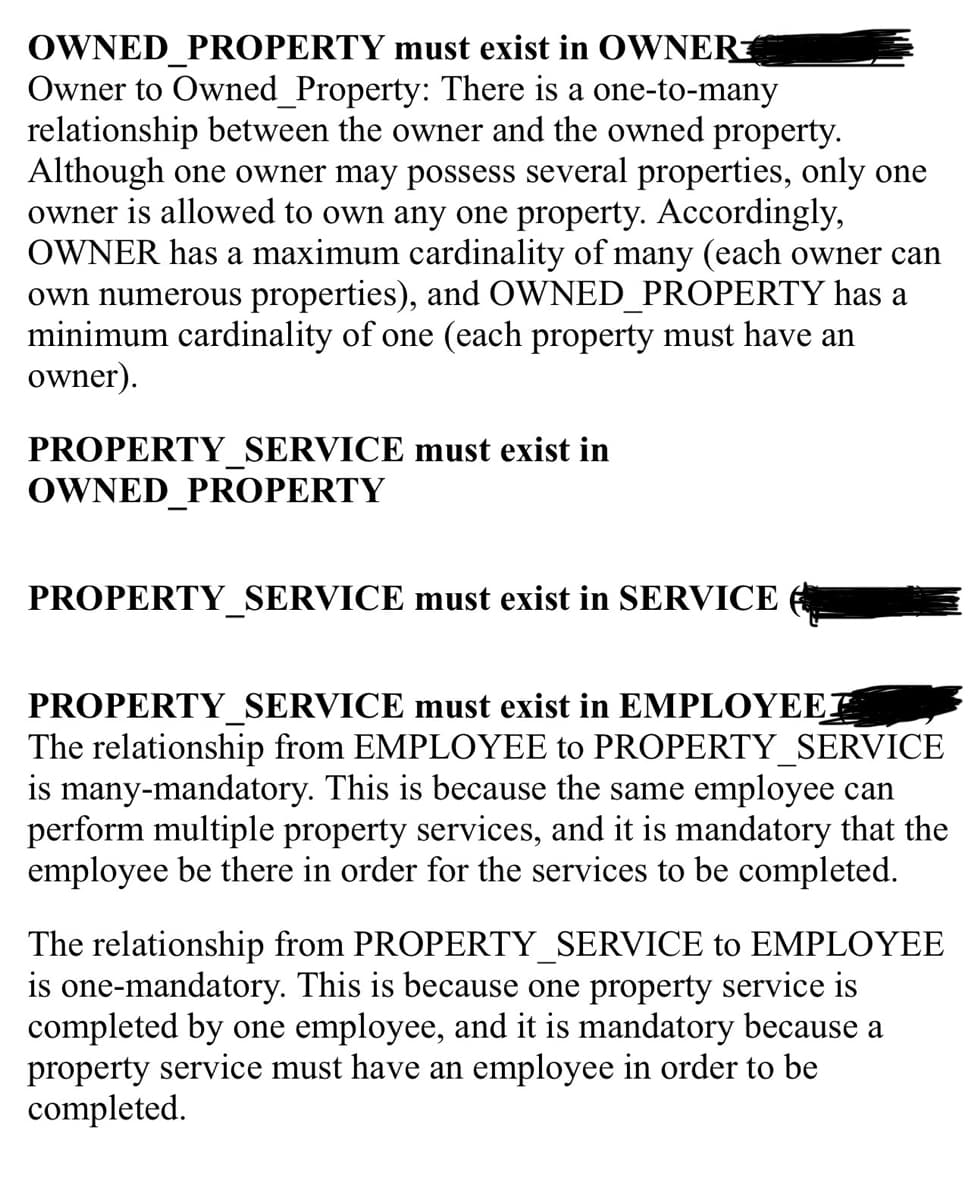Assume that Garden Glory designs a database with the following tables: OWNER (OwnerID, OwnerName, OwnerEmailAddress, Owner Type) OWNED PROPERTY (PropertyID, PropertyName, Property Type, Street, City, State, Zip, OwnerID) GG SERVICE (ServiceID, ServiceDescription, CostPerHour); EMPLOYEE (EmployeeID, LastName, FirstName, CellPhone, ExperienceLevel) PROPERTY SERVICE (PropertyServiceID, PropertyID, ServiceID, ServiceDate, EmployeeID, Hours Worked) The referential integrity constraints are: OwnerID in OWNED PROPERTY must exist in OwnerID in OWNER PropertyID in PROPERTY_SERVICE must exist in PropertyID in OWNED_ PROPERTY ServiceID in PROPERTY_SERVICE must exist in ServiceID in GG_SERVICE EmployeeID in PROPERTY SERVICE must exist in EmployeeID in EMPLOYEE Assume that Own OPERTY ServiceID in GG SER OWNED PROPERTY must exist in OWNER Owner to Owned_Property: There is a one-to-many relationship between the owner and the owned property. Although one owner may possess several properties, only one owner is allowed to own any one property. Accordingly, OWNER has a maximum cardinality of many (each owner can own numerous properties), and OWNED_PROPERTY has a minimum cardinality of one (each property must have an owner). PROPERTY SERVICE must exist in OWNED PROPERTY PROPERTY SERVICE must exist in SERVICE PROPERTY_SERVICE must exist in EMPLOYEET The relationship from EMPLOYEE to PROPERTY_SERVICE is many-mandatory. This is because the same employee can perform multiple property services, and it is mandatory that the employee be there in order for the services to be completed. The relationship from PROPERTY_SERVICE to EMPLOYEE is one-mandatory. This is because one property service is completed by one employee, and it is mandatory because a property service must have an employee in order to be completed.
Assume that Garden Glory designs a database with the following tables: OWNER (OwnerID, OwnerName, OwnerEmailAddress, Owner Type) OWNED PROPERTY (PropertyID, PropertyName, Property Type, Street, City, State, Zip, OwnerID) GG SERVICE (ServiceID, ServiceDescription, CostPerHour); EMPLOYEE (EmployeeID, LastName, FirstName, CellPhone, ExperienceLevel) PROPERTY SERVICE (PropertyServiceID, PropertyID, ServiceID, ServiceDate, EmployeeID, Hours Worked) The referential integrity constraints are: OwnerID in OWNED PROPERTY must exist in OwnerID in OWNER PropertyID in PROPERTY_SERVICE must exist in PropertyID in OWNED_ PROPERTY ServiceID in PROPERTY_SERVICE must exist in ServiceID in GG_SERVICE EmployeeID in PROPERTY SERVICE must exist in EmployeeID in EMPLOYEE Assume that Own OPERTY ServiceID in GG SER OWNED PROPERTY must exist in OWNER Owner to Owned_Property: There is a one-to-many relationship between the owner and the owned property. Although one owner may possess several properties, only one owner is allowed to own any one property. Accordingly, OWNER has a maximum cardinality of many (each owner can own numerous properties), and OWNED_PROPERTY has a minimum cardinality of one (each property must have an owner). PROPERTY SERVICE must exist in OWNED PROPERTY PROPERTY SERVICE must exist in SERVICE PROPERTY_SERVICE must exist in EMPLOYEET The relationship from EMPLOYEE to PROPERTY_SERVICE is many-mandatory. This is because the same employee can perform multiple property services, and it is mandatory that the employee be there in order for the services to be completed. The relationship from PROPERTY_SERVICE to EMPLOYEE is one-mandatory. This is because one property service is completed by one employee, and it is mandatory because a property service must have an employee in order to be completed.
Practical Management Science
6th Edition
ISBN:9781337406659
Author:WINSTON, Wayne L.
Publisher:WINSTON, Wayne L.
Chapter11: Simulation Models
Section11.4: Marketing Models
Problem 30P: Seas Beginning sells clothing by mail order. An important question is when to strike a customer from...
Related questions
Question
What would the two blank ones be?

Transcribed Image Text:Assume that Garden Glory designs a database with the following tables:
OWNER (OwnerID, OwnerName, OwnerEmailAddress, Owner Type)
OWNED PROPERTY (PropertyID, PropertyName, Property Type, Street, City,
State, Zip, OwnerID)
GG SERVICE (ServiceID, ServiceDescription, CostPerHour);
EMPLOYEE (EmployeeID, LastName, FirstName, CellPhone, ExperienceLevel)
PROPERTY SERVICE (PropertyServiceID, PropertyID, ServiceID, ServiceDate,
EmployeeID, Hours Worked)
The referential integrity constraints are:
OwnerID in OWNED PROPERTY must exist in OwnerID in OWNER
PropertyID in PROPERTY_SERVICE must exist in PropertyID in OWNED_
PROPERTY
ServiceID in PROPERTY_SERVICE must exist in ServiceID in GG_SERVICE
EmployeeID in PROPERTY SERVICE must exist in EmployeeID in EMPLOYEE
Assume that Own
OPERTY ServiceID in GG SER

Transcribed Image Text:OWNED PROPERTY must exist in OWNER
Owner to Owned_Property: There is a one-to-many
relationship between the owner and the owned property.
Although one owner may possess several properties, only one
owner is allowed to own any one property. Accordingly,
OWNER has a maximum cardinality of many (each owner can
own numerous properties), and OWNED_PROPERTY has a
minimum cardinality of one (each property must have an
owner).
PROPERTY SERVICE must exist in
OWNED PROPERTY
PROPERTY SERVICE must exist in SERVICE
PROPERTY_SERVICE must exist in EMPLOYEET
The relationship from EMPLOYEE to PROPERTY_SERVICE
is many-mandatory. This is because the same employee can
perform multiple property services, and it is mandatory that the
employee be there in order for the services to be completed.
The relationship from PROPERTY_SERVICE to EMPLOYEE
is one-mandatory. This is because one property service is
completed by one employee, and it is mandatory because a
property service must have an employee in order to be
completed.
Expert Solution
This question has been solved!
Explore an expertly crafted, step-by-step solution for a thorough understanding of key concepts.
This is a popular solution!
Trending now
This is a popular solution!
Step by step
Solved in 1 steps

Recommended textbooks for you

Practical Management Science
Operations Management
ISBN:
9781337406659
Author:
WINSTON, Wayne L.
Publisher:
Cengage,

Practical Management Science
Operations Management
ISBN:
9781337406659
Author:
WINSTON, Wayne L.
Publisher:
Cengage,